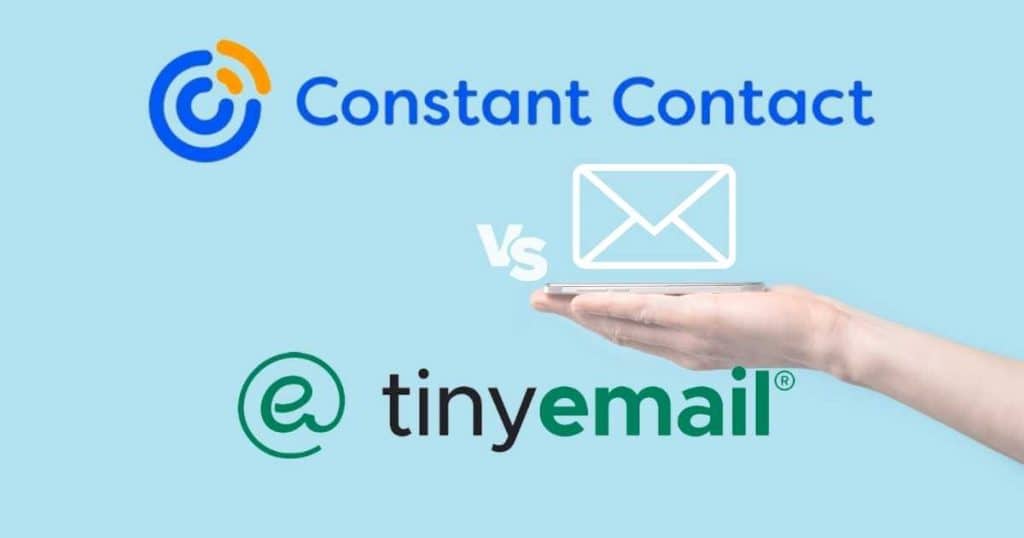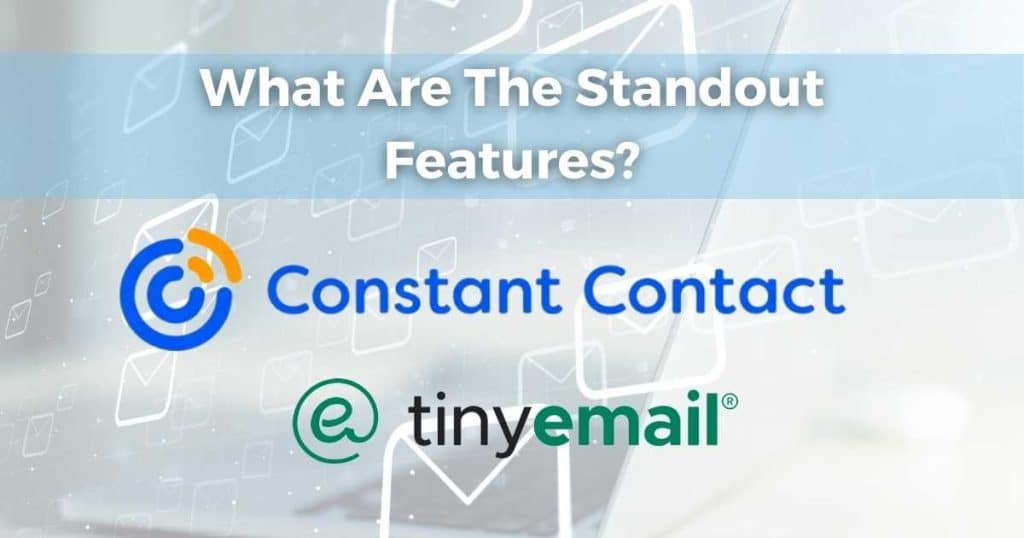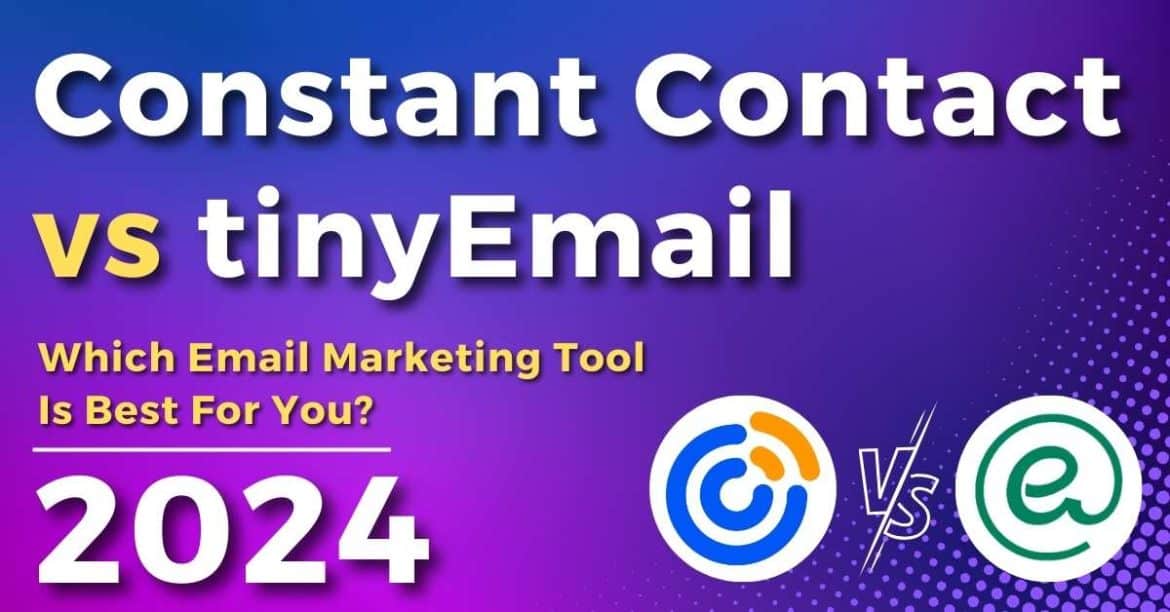Constant Contact vs tinyEmail – which email marketing tool can take your business to new heights?
Did you know email marketing is still the most effective way to connect and nurture relationships with prospects and existing customers?
But with so many impressive email marketing tools competing for your attention, the dilemma of which one to choose can be daunting.
The good news is, if you’re struggling to pick between Constant Contact and tinyEmail, you’re on the right track!
But the question is, what are the key differences between the two, and which is best for you?
Read more: Top 5 Best FREE Email Marketing Software For Small Business.
Quick Summary
- Constant Contact is a leading email marketing tool best for beginners after omnichannel capabilities and complex segmentation, automation, and reporting tools.
- tinyEmail is a simplistic Constant Contact alternative for individuals or teams looking for a basic email marketing platform to enhance and manage their email newsletters.
- The cheapest of the two is tinyEmail with a free plan and affordable paid plans, whereas Constant Contact is slightly more expensive (and doesn’t have a free plan).
Constant Contact vs tinyEmail 2024

I will be diving head first into Constant Contact and tinyEmail to unravel their features, strengths, and weaknesses to uncover – which is the perfect fit for your business?
Whether you’re a seasoned entrepreneur or just starting your business journey, fasten your seatbelts and prepare for a thrilling exploration of Constant Contact and tinyEmail!
By the end of this comprehensive comparison guide, you should know which email marketing tool is best for you.
Read more: Omnisend vs tinyEmail.
What Are They? Constant Contact vs tinyEmail
Founded in 1998, Constant Contact is one of the oldest and largest email marketing platforms in the game.
Offering customizable email templates, seamless contact management, and automation capabilities, it’s perfect for newbies looking to enhance their email marketing strategies!
On the other hand, tinyEmail, a newcomer on the scene (2020), has quickly gained popularity due to its simplicity and affordability.
With a refreshing and straightforward approach, tinyEmail enables you to create visually stunning emails, manage contacts, and track campaign performance effortlessly!
Basically, tinyEmail proves that effectiveness doesn’t have to be sacrificed for simplicity!
While Constant Contact’s longevity may instill confidence, tinyEmail’s agile capabilities give it a competitive edge.
So, in the battle between experience and innovation, which email marketing tool will ultimately come out on top?
It’s time to find out.
Read more: Constant Contact Pros and Cons.
What Are The Differences Between Constant Contact vs tinyEmail?

Constant Contact and tinyEmail give you the tools you need to send captivating email campaigns.
So, what sets them apart?
The main difference between the two is their feature sets.
Constant Contact stands out with its comprehensive email and omnichannel marketing features, catering to teams looking to elevate their email campaigns!
Conversely, tinyEmail presents a stripped-down and cost-effective alternative, ideal for users who don’t require extensive features.
With that said, let’s dive into the ins and outs of each platform.
Read more: Top 5 Constant Contact Alternatives.
Ease Of Use
Both Constant Contact and tinyEmail cater to beginners with their highly visual interface, pre-designed templates, and user-friendly menus.
But there are some differences between the two!
Constant Contact stands out by offering users a seamlessly intuitive interface with a drag-and-drop editor, making email creation a breeze (even for total beginners!)
And the best part is that you don’t have to learn an ounce of code with their visual editor and pre-designed templates.
With easy access to all essential features from the main menu, users can swiftly construct subscriber lists, develop campaigns, and analyze results with just a few clicks.
Overall, Constant Contact does a great job of prioritizing simplicity without skimping on advanced functionality!
In comparison, tinyEmail is known for its simplistic approach to email marketing – and boy, does it deliver!
The simple email editor and drag-and-drop templates enable new users to create and send attractive emails efficiently.
However, advanced features such as automation rules or custom HTML templates may be harder to find and use.
And while the interface is easy to use, Constant Contact shines here, catering to both beginners and teams looking to scale their businesses.
It’s no wonder that Constant Contact still stands as a popular email marketing platform all these years later!
Winner = Constant Contact.
Read more: ActiveCampaign vs Constant Contact.
Pricing
Constant Contact:
Constant Contact has three plan options:
- Lite: $30 per month (1000 contacts).
- Standard: $55 per month (1000 contacts).
- Premium: $110 per month (1000 contacts).
You’ll get marketing CRM and integrations on all plans, but the lowest pricing plan doesn’t offer automation or segmentation capabilities.
tinyEmail:
tinyEmail has four plans, with the price of each depending on your email sends per month.
The following plan prices are based on teams sending up to 15k monthly emails:
- Free: $0 – Includes 500 subscribers.
- Standard: From $15 per month.
- Pro: From $69 per month.
- Custom: Custom pricing.
tinyEmail also offers a dedicated Shopify plan, which is completely free for Shopify users!
Winner = tinyEmail.
Read more: ActiveCampaign vs tinyEmail.
Constant Contact vs tinyEmail Key Features:

Email Templates
Both tools let you create and send professional email campaigns with the help of customizable email templates – but is there one that does it better?
Constant Contact offers hundreds of professionally designed and mobile-friendly promotional, newsletter, invitation, or seasonal email templates.
The template editor in Constant Contact simplifies the process of customizing each template’s colors, fonts, and design elements.
Additionally, you can easily drag and drop your desired content blocks into the template.
These modern and visually captivating designs help your emails stand out from the crowd.
In contrast, tinyEmail offers a more limited selection of 50+ newsletter, promotion, welcome series, and notification email templates.
You can use the drag-and-drop editor in tinyEmail to change colors, fonts, and images, but the customization options for layouts are more restricted compared to Constant Contact.
While tinyEmail’s templates serve their purpose, achieving a polished and branded look may require additional effort.
Basically, the template options in tinyEmail are suitable for straightforward transactional and promotional emails.
But if you’re after visually dynamic, flexible, and professionally designed templates, you might find Constant Contact’s selection far superior!
Winner = Constant Contact.
Read more: Best MailerLite Alternatives.
Automation
I’ll be honest: Constant Contact and tinyEmail’s automation capabilities aren’t the best in the market.
So who wins this one?
Constant Contact’s simple automation triggers help you effectively engage with your audience and streamline your email marketing workflows.
These triggers consist of:
- Welcome emails.
- Email series to nurture leads.
- First purchase or abandoned cart emails.
- Date-based sequence flows based on subscriber actions.
You can personalize content, schedule sends with delays or on specific dates, and segment your lists to target specific groups through the easy-to-use automation builder.
Additionally, the platform offers open-and-click tracking to monitor the performance of your automation campaigns.
It’s worth mentioning that while you can set up multi-step automations through the visual workflow builder, the functionality is limited.
tinyEmail also offers basic automation capabilities.
The platform’s drag-and-drop builder allows for easy layout and content design for automated emails.
And you can create welcome emails for new subscribers, email sequences triggered by dates, and abandoned cart emails.
In saying this, you can’t define specific actions, edit the content, or use conditional logic and segmentation for more complex automation workflows.
Although both tools are basic, Constant Contact emerges as the winner for automation due to its conditional logic, sophisticated customer journey workflows, and tracking capabilities.
Winner = Constant Contact.
Read more: ActiveCampaign Review.
Segmentation
Constant Contact’s segmentation capabilities are sufficient for small teams wanting to create customer segments based on demographics, interests, engagement data, and more.
Some features include:
- An intuitive segment builder.
- Contact tagging.
- If/then contact filtering.
- Up to 5 segmentation rules.
- Google Analytics integration.
With these tools by your side, you can easily set up segments based on subscriber attributes like location, purchase history, and customer engagement.
tinyEmail also surprisingly provides a decent number of segmentation features for a reasonably basic email marketing tool.
Like Constant Contact, you can also create segments based on various conditions such as email activity, date subscribed, and demographic data.
I particularly like that the AI-powered ‘recommended segments’ tool automatically generates segments based on shared characteristics among subscribers!
This allows for targeted AI re-engagement email campaigns or emails that contain special vouchers to subscribers with upcoming birthdays.
tinyEmail also provides a segment breakdown showing the percentage of subscribers who’ve clicked, opened, or unsubscribed from your emails.
However, it’s worth noting that tinyEmail lacks advanced behavioral segmentation options such as purchase history.
Winner = Constant Contact.
Read more: How To Use Google Analytics?
Constant Contact vs tinyEmail Standout Features

Constant Contact is so much more than just email marketing.
Simply leverage AI technology with their AI content generator, expand audience engagement with SMS marketing, and find new customers through social media marketing techniques.
With social quick-share buttons, Constant Contact makes it easier for subscribers to share your emails on their social media platforms, simplifying social media marketing automation.
Additionally, the platform seamlessly integrates with Google Workspace, allowing you to seamlessly sync your contacts from your Google account directly into your email lists!
And if you’re after a basic built-in CRM for contact management or third-party eCommerce capabilities, Constant Contact has you covered.
And finally, their super fun and interactive survey and poll creation feature that you can seamlessly add to emails will help you collect valuable feedback from your audience.
Although tinyEmail primarily focuses on core email marketing features, it does offer some additional functionalities!
One of these features is the ability to create basic surveys with customizable questions, allowing you to gather feedback from your subscriber list.
Another useful feature is the RSS-to-email functionality, allowing you to email your blog content directly to your subscribers’ inboxes (instead of them going to your website).
Additionally, tinyEmail supports email comments, enabling readers to respond to your messages directly.
While tinyEmail covers the essentials of email marketing well, Constant Contact provides a more comprehensive set of integrated marketing features and tools beyond just email.
Winner = Constant Contact.
Read more: ActiveCampaign vs MailChimp.
Constant Contact vs tinyEmail Customer Support
Effective and responsive customer support is crucial to any software solution, right?
So, how well do both stack up?
Constant Contact goes above and beyond to provide comprehensive assistance with 24/7 support through phone, chat, email, and social channels.
Additionally, their extensive library of tutorials and onboarding resources lets you familiarize yourself quickly with the platform.
tinyEmail’s email and in-app messaging support during business hours is certainly helpful.
However, its educational materials are where it lets itself down, with limited materials compared with Constant Contact.
This disparity in available resources may impact the level of support and guidance that tinyEmail users can receive – therefore, we have to give this win to Constant Contact.
Winner = Constant Contact.
Constant Contact vs tinyEmail Who Are They Best For?

I know what you’re thinking….Constant Contact thrashed tinyEmail in most categories!
But that doesn’t mean that you should rule out using tinyEmail completely.
Constant Contact is the go-to choice for growing businesses seeking a more complex email marketing tool to execute sophisticated campaigns effortlessly.
The platform excels in providing highly professional and visually engaging emails through its extensive template library and automation, segmentation, and omnichannel capabilities.
In contrast, tinyEmail is best suited for solopreneurs, startups, and smaller businesses with more straightforward email marketing needs.
Basically, tinyEmail’s affordability and ease of use are ideal for teams just getting started!
Additionally, if you’re a Shopify store user, you’ll love tinyEmail’s free Shopify plan and deep native integration with order tracking and customer flow management!
While tinyEmail lacks the advanced features of Constant Contact, I believe it covers the essentials of email marketing pretty darn well.
Stews Final Thoughts
That wraps up this honest Constant Contact vs tinyEmail comparison guide!
Don’t forget, Constant Contact has decades of experience over tinyEmail, so who knows what tinyEmail will become over the years to come!
Whether you’re after basic email marketing needs or a more comprehensive email marketing solution, Constant Contact and tinyEmail are two great solutions.
Still not convinced that either platform is for you? Check out my unbiased Top 5 Constant Contact Alternatives article, where I dive into other awesome email marketing tools!
Regardless of what you choose, let me know below!

